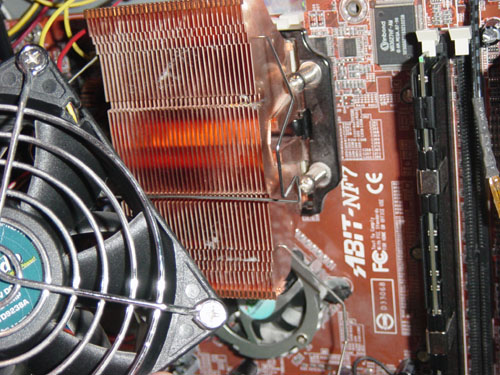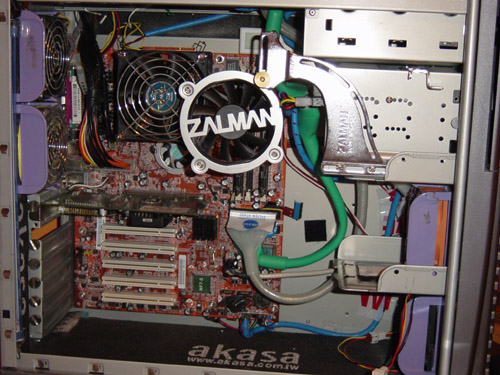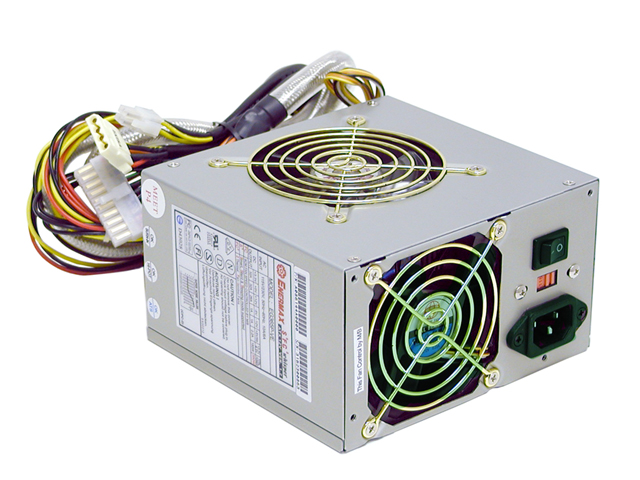| Introduction |
| |
| This guide covers the following NF7 issues. |
| |
| 1. Detailed Requirements & Voltage issues |
| 2. The missing 10/10.5x multipliers over 225 MHz FSB with CPU-Interface enabled. |
| 3. The 220 FSB wall with a tbred |
| 4. CPU Interface issues |
| 5. Different "better" bios versions |
| 6. How long to run prime and what to look for |
| 7. How to recover from potential non POST'ing |
| 8. Memory/timing and restrictions. |
| |
|
If you are not yet familiar with the basics of overclocking with nforce 2 based boards, please have a bash at this guide:
nForce 2 overclocking - Level One before
proceeding with this guide. It guides you through the various levels of speed and stability and is very important you find
this level before venturing straight into this guide.
|
| |
| Minimum Specs: (rough guide): |
| |
|
Abit NF7 V2.0 series (Vanilla, S and M versions)
|
|
A good Overclocking cpu ie. Barton 2500+/2800+/3000+/3200+ or T'bred B 1700+/1800+ JIUHB, or 2100+/2600+/2700+
AIUHB (Please note chips after week #39 have locked multipliers)
|
|
Either 256MB (single channel) or 512MB (2x 256 DIMM's in dual channel) or the same with 512MB Dimms
|
|
GOOD QUALITY MEMORY I canít emphasise this enough either PC3200/PC3500/PC3700 Mushkin/corsair/kingston/OCZ/Geil
etc will do
|
|
A "Quality" PSU 350W or greater (however, keep reading if you have a 300 Wattíer )
|
|
Good case ventilation at least 1 intake and 1 outake fan (if in doubt rip the side off and blow a house fan over
the system)
|
|
Good CPU Cooling, see below for a recommendation
|
| |
|
** Also if your and owner of a early NF7 board feel free to try these tips, i have seen one guy who tried this guide out
and hit 240fsb on a v1.0 board on the first try. Just please ignore any mentions of different bios versions as they only
apply to the 2nd revision of the board **
|
| |
| 1. Detailed Requirements & Voltage issues |
| |
| Cooling: |
| |
|
CPU Cooling - This guide can be followed with Air/Water cooling and obviously Better.If youíre using air-cooling Iíd
recommend investing a decent heatsink, just go straight for the best if you can. I can personally highly recommend the
Thermalright SLK900U and a 92mm fan as a good option.
|
| |
 |
| |
|
Chipset Cooling - Well to be fair most boards donít need very high vdd voltage so this is not something to really worry about however, there
are some steps you can take if you prefer to improve on it. The easiest and by far the cheapest way is to re apply a decent
TIM to the northbridge. The stock board comes with very poorly applied white goop. Iíd recommend cleaning it off and
applying decent compound, preferably arctic silver. As far as getting a better cooler its totally up to you, in my opinion
stock cooling is plenty good enough for starters. I've had 250FSB out of a stock cooled NF7-S V2.0, even before changing
the compound on it. Information on how to do this can be found at
http://www.motherboardfaqs.com.
|
| |
|
System Cooling - Iíd really recommend you ensure you have good airflow in the case. If your average system temp is above
30*C under load (depending on your ambient temp) then you need to rethink your air-flow, make sure you have the same amount
of CFM blowing out as well as in. A side fan be on a PCI bracket or an actual blowhole helps to an extent by reducing
graphics card temperature and thus overall system temperature.
|
| |
 |
| |
| Power & Vcore / vdimm and +3.3v rail requirements: |
| |
| Ok power, very important issues here so listen carefully. |
| |
|
A lot depends on the quality of the psu the way itís rated and the amperage it supplyís. For example PC Power and cooling
rate their psu's overall power output at 40*C operating conditions, Enermax rate them at 25*C so its hard to make a
comparison wattage to wattage as psu's perform better the colder they are. Therefore the wattage rating becomes meaningless.
|
| |
|
Have a look at this pdf to understand what I mean:
http://www.pcpowerandcooling.com/pdf/Turbo-Cool_510_vs.pdf
|
| |
|
Basically at 40*C the PC Power and cooling can supply 510W the other can only produce 366W see the difference? Some
manufacturers even rate thier PSU's at 0*C which is truly ridiculous. On newegg.com's site (USA) they show something
like: "MTBF: 100K hours at 25ļC" this means the maximum power output is rated to work for 100,000 hours at 25*C. Some
are not specified which makes me wary (thermaltake/qtec doesnt give info btw).
|
| |
|
So in a nutshell a 550W is not essentially a 550W PSU, if in your room it operates at 50*C it could only be supplying
you with as low as 244W!!!!!!.
|
| |
| Take these two as an example: |
| |
|
Enermax EG365P-VE(FC). 350W Power supply
|
| |
| @$51.00 |
| Maximum Power: 350W |
| Output: |
| +3.3V@32A |
| +5V@32A |
| +12V@26A |
| |
|
Thermaltake Silent PurePower, 420W ATX power supply
|
| |
| @$49.00 |
| Maximum Power: 420W |
| Output: |
| +3.3V@30A |
| +5V@40A |
| +12V@18A |
| |
|
The Enermax has a slightly stronger +3.3v rail, which helps ram voltage stability and the +12v/5+ helps when using
high-powered CPUís. However the motherboard uses a combination of the +5v and +3.3 so the 40A on the thermaltake will
help but it just shows the true difference in the psu's, the large gap in power output means very little.
|
| |
 |
| |
|
Having personal experience with Enermax (I use a 460W Enermax) Iím pleased with it, copes with every thing Iíve thrown at
it so far it has 35A amps on the +5V and 35A on the +3.3v it holds up at high overclockís very well. The +5v rail is rock
solid at 5.03volts under load. The +3.3v rail is often above 3.34v under load at reasonable vdimm levels. However all PSUís
can be improved on by vmodding. Check out the forums at http://www.xtremesystems.org if youíre interested.
|
| |